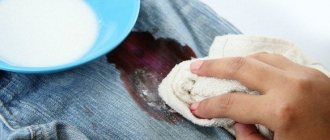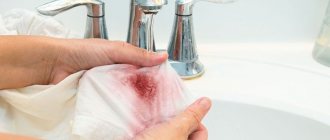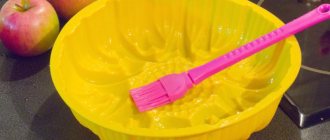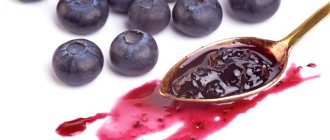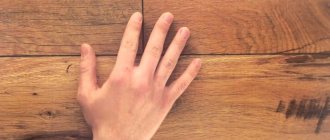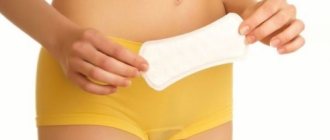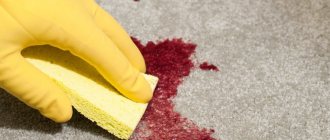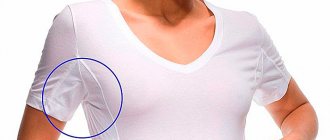How to remove blood from sheets and underwear is a sensitive and pressing question for every girl and woman. Any of us sooner or later encounters pollution during menstrual periods. Getting rid of menstrual marks is more difficult than getting rid of similar ones after cuts and wounds. After all, this is not just blood, but a mixture of enzymes, mucus and secretions, which is why it does not clot.
Using professional products
If you can’t remove blood stains with improvised means, store-bought stain removers will come to the rescue. They come in the form of liquids, gels, powders and sticks.
The most effective brands of stain removers against blood:
- Liquid Dr. Beckmann (150 rubles). The product is applied to the blood and left for 10 minutes. Residues are washed off with normal washing. Besides the blood of Dr. Beckmann copes with almost all types of dirt. The downside is the small volume of the bottle and high cost.
- Vanish stain remover (140 rubles). Available in separate series for white and colored linen. The concentrated liquid is poured onto the stain, left for 30 seconds, and then 1 capful is added to the powder and the item is finally washed in the machine. Vanish is suitable for soaking. The disadvantage is that it is not always possible to remove the stain the first time.
- Amway spray (600 rubles). The composition is sprayed onto the blood (distance 15 cm) and washed in the usual way. The spray has a pleasant citrus scent and is easy to use. The disadvantages of the product are the high cost and the need to re-process old blood traces.
Most stain removers are applied pointwise, forming a chemical reaction upon contact with dirt. Such compounds are dangerous for sensitive skin. Therefore, it is better to wash children's bedding with gentle products (Eared Nanny, Meine Liebe, Our Mother, Umka, etc.).
You can remove blood from bed linen using folk remedies and store-bought stain removers. Fresh dirt that has not had time to dry can be easily removed with cold water. To combat old marks that have gone through more than one wash, you will have to use aggressive compounds that can ruin the color and structure of the fabric fibers.
What not to do
When dealing with scarlet marks, it is not recommended to:
- Use hot water. Under its influence, the blood will only penetrate deeper into the fibers, so prohibiting the use of boiling water is one of the important conditions for success.
- Use a stiff brush. It will rub the stain and make it even wider.
- Wash immediately. This type of stain requires a long preliminary soaking. During the process, water saturates the fibers of the fabric and prevents blood particles from settling between the threads.
- Store dirty laundry for a long time. The further you delay the washing process, the less chance you have of saving your items.
- Immediately use folk remedies. The market is full of stain removers that are much more effective and convenient than available products.
We hope that the materials from our article helped you solve the problem of how to remove old blood stains and remove the slightest reminder of them. But if all of the above methods do not bring the expected effect, do not rush to give up and say goodbye to your clothes. Even such a problem can be solved simply and creatively: decorate the place with embroidery, appliqués or patches. Then your item will receive a new life and become exclusive.
How to remove dried blood
It is worth knowing a certain pattern: the longer a substance comes into contact with the surface, the more problematic it is to wash it. Moreover, the situation becomes more complicated if the item has already been processed in boiling water or dried on a radiator.
First, the affected area is wetted in cold water, and then ammonia is used.
It is advisable to remember the following recommendations:
Before washing, the contaminated surface can be scrubbed with a stiff brush. This will help remove caked on and old stuff.
You cannot immediately throw the item into the washing machine without pre-treatment. If the damaged area is large, then it is cleaned by applying a clean rag until the marks stop being printed. When using special preparations, it is important not to smear dirt on the surface. For example, treatment of smudges begins from the edges and gradually approaches the central part. After applying the special chemical, you should wait five minutes and then treat the area with dry material. Do not iron blood stains
After ironing or steaming, the likelihood of removing blood is close to zero. To resuscitate sheets, it is necessary to soak them for a long time in a highly concentrated soap composition. First of all, the stained area must be softened and weakened. You should not resort to acetone and other solvents, but use an infusion of ammonia after determining the reaction of the texture. If smudges or yellow stains appear after drying. Recipes based on regular soda or vinegar will help wash blood from fabric. To prevent infection, be sure to use gloves, as pathogenic bacteria can get into open wounds.
Let the substance act - wait at least eight hours. Rinse or wash items thoroughly.
As for white things, you can’t do without a stain remover. The chemical is also used for light-colored jeans. Even if you manage to get rid of the main contamination, a barely noticeable glare may still remain
Therefore, it is important to find or buy a suitable chemical as quickly as possible, and then follow the manufacturer’s instructions. Usually, a minimum amount of concentrate is poured into a container, the textiles are soaked and washed.
To ensure a guaranteed effect, this technique is carried out repeatedly. All other methods in this case will most likely be useless and the unpleasant mark will still not disappear.
Pour the solution onto the stain, making sure the cloth is sufficiently wetted with the solution.
Review of effective remedies for removing blood stains
Blood stains are difficult to remove. Folk remedies and household chemicals come to the rescue. If you need a quick effect, it is better to use special means. If savings are important, then traditional methods are the best option.
Special means
Popular household chemical stain removers for removing old and fresh stains:
| Name | Minuses | pros |
| ACE OXI MAGIC |
|
|
| Udalix Oxi Ultra |
| |
| Astonish OXY PLUS |
|
|
| Sarma Active 5 in 1 |
|
|
According to housewives, effective stain removers:
- the baby's sheet will be washed with soap and bleach by the Eared Nanny;
- Sarma Active 5 in 1 powder is highly effective in cool water;
- economical option - Udalix Oxi Ultra;
- white linen will be washed by Bos Plus Maximum;
- ACE OXI MAGIC powder has gained popularity;
- Astonish OXY PLUS is suitable without harm to color.
The following products showed good results in quickly removing traces of blood:
- Vanish.
- Ekove.
- Frau Schmidt.
When using stain removers, you should follow the instructions to avoid damaging the fabric fibers.
Traditional methods
You can remove blood stains from clothes at home using folk remedies.
Washing should be done in cold water. The length of soaking will depend on how long the stain has been present.
- When the blood is fresh, you should soak the material twice for half an hour.
- During menstruation, immediately wash panties and robe with cool water. Apply vinegar or chalk. Place the substance on the wet material for 25 minutes. Rinse.
- Heat a bottle of glycerin. Soak a cotton swab in it and cover the dry area. Wait up to 5 minutes without mashing. It should draw out the dirt. Hand wash the fabric using laundry soap, do not rinse it off and throw it in the washing machine. The temperature is maintained up to 40 degrees.
- Effectively removes traces of glass cleaner. Lay the sweater on the table and spray the mark with a spray bottle. Wait 10 minutes, gently rub with a brush. After 30 minutes, rinse the product.
- Citric acid will help remove blood from white carpeting. Soak it in boiling water. When the solution has cooled, place it on a cloth using a pipette. Wait until dry, wash by hand.
- For colored fibers, lemon pulp is suitable. Squeeze the juice from 2 lemons. Place the pulp for 25 minutes. Handwash only.
For old marks, cornstarch is suitable.
First thing
If you find a bloody stain on a fabric, do not soak the item in hot water. The protein contained in the blood will coagulate under the influence of high temperature, and the stain will not be removed.
It would be correct to immediately place the contaminated area of fabric in ice water for half an hour, and after the time has elapsed, change the water and maintain the same interval again. After this, you can wash the product by hand with laundry soap, and only when the stain disappears, wash it as usual in a washing machine.
However, this method can help if the stain is fresh. To remove old blood stains, you need to try other methods.
Boiling water and blood stains
Hot water should never be used to remove menses. After this, the item will be ruined forever, and stain removers will not help.
Blood begins to clot at temperatures above 40 degrees. Blood protein is destroyed under such influence, so it is intensively absorbed by the fibers.
The women try to remove the marks left behind with hydrogen peroxide, but the solution either spoils the design or burns through the delicate material. If you really want to save an expensive item, you should contact a dry cleaning specialist.
Old, dried out
Traces of blood that have already dried will be much more difficult to remove. If the recipe you are using does not help, you can use another one.
It is advisable to start processing by soaking the entire item in cold water. This technique will prepare the fabric for further processing.
For relatively fresh stains, it is enough to keep the clothes in water for an hour, for old traces of blood (if the type of fabric allows) - longer, 2-3 hours.
If, after soaping with Antipyatin or laundry soap, the stain does not go away completely, proceed to removing the marks using one of the recipes.
Dishwashing gel
Shampoo or dish soap can be used to remove stains if nothing else is available and the stain is not yet old.
To do this, moisten the material, apply the selected preparation and rub gently. After 10 minutes, wash and rinse the item.
Another way is to apply undiluted dishwashing gel directly to the stained area of the material. Apply liberally, not in a thin layer.
After this, cling film is placed on top and left in this form for a couple of hours or even more, up to five. After this, the product is washed.
Hydrogen peroxide
White items can be treated with hydrogen peroxide, but only if the material is natural (cotton, linen) and dense.
Stain removal procedure:
- Use a bottle of peroxide to pour over the stain. Or treat it using a sponge.
- Allow time for the chemical reaction to take place.
- Wash the item.
You can enhance the effect if you add ammonia to the peroxide. These liquids should be combined in equal proportions.
This method is only suitable for fairly dense fabrics and is not recommended for delicate ones.
Salt
To remove a stain, you need to prepare a solution:
- pour 3 liters of cold water into a basin;
- add 60 grams of salt;
- stir;
- dip soiled clothes;
- leave for 6-8 hours;
- wash with Antipyatin or laundry soap;
- rinse.
For delicate fabrics, the option with salt is undesirable.
Soda
Removing stains with soda is carried out according to the following method:
- Pour 1 glass of cold water into a container.
- Pour 10-15 grams of soda into it.
- Stir.
- Pour the solution onto the mark.
- Leave for 30 minutes.
- Rub the dirty area.
- Wash the item using detergent.
The recipe is designed for thick fabric.
Ammonia
Ammonia allows you to remove blood from clothes, sheets and other soiled items made from linen or cotton.
Procedure:
- pour 3 liters of water into a basin;
- pour in 60 ml. ammonia;
- soak the thing;
- keep in the solution for a couple of hours.
Potato starch
For thick cotton and linen fabrics, you can use almost any of the recipes, but for delicate items you need to proceed differently:
- Pour ½ cup of starch into a container.
- Add a little water to form a paste.
- Apply the mixture to the fabric.
- Set the item aside for the time necessary for the paste to dry completely.
- Clean any remaining slurry from the material with a dry cloth or towel.
- Wash the product.
Vinegar
Table vinegar, thanks to the acid it contains, can be a good stain remover. A local stain can be treated with undiluted liquid and left for half an hour.
If there are several stains in different places, it would be better to prepare a solution of two parts water and one part vinegar. The item is completely dipped into it and left for 10-15 minutes, after which it is washed.
For vinegar to be 100% effective and completely remove stains, it should be used within the first 24 hours after the mark is formed. After this period, acetic acid will be less effective.
Glycerol
Glycerin is often used to remove stains. For the best effect of the manipulation, the bottle with glycerin should be warmed up a little so that it becomes warm.
Using a cotton swab, treat the blood stain while the glycerin is still warm. After removing the stains, the item is washed and rinsed.
Lemon and salt
Lemon juice is a natural product that helps in removing a variety of stains. Citric acid, like acetic acid, can also cope with blood stains.
For cleaning, prepare the following mixture:
- in a container mix 2 tbsp. l. lemon juice and 1 tbsp. l. salt;
- Using an old toothbrush, treat the fabric;
- Rinse the material with cold water.
The disadvantage of this method is its relatively low effectiveness against large or old stains. And the impossibility of using on colored fabrics.
Rule 2. Wash the protein from the fibers
Often the recipes from the list above are enough to remove old blood stains. But some types of fabrics are not recommended to use such methods. They deteriorate hopelessly and even dissolve. Therefore, folk wisdom has come up with several more ways. The options are more gentle, but, nevertheless, also very effective.
The most famous:
- Dishwashing liquid.
It is diluted with water in a ratio of 1 to 1, and rubbed into the stain with gentle movements. Safely forgotten for 30-40 minutes. It is recommended to rub the fabric a little more before washing. - Baking soda.
For 1 liter of boiled, cooled water, take 2 tbsp. l. with a powder top. Stir thoroughly. Then the soiled item is soaked in the resulting liquid. For at least 10 hours. Periodically, lightly rub the fabric with a soft brush or your hands. Afterwards, the “test” is rinsed and washed with the addition of good powder. - Ammonia.
For half a liter of clean water, take approximately 10 ml of ammonia. Stir thoroughly, then soak the damaged item until the blood mark disappears. If the composition of the fabric allows, then you can slightly increase the concentration of ammonia. This will significantly speed up the cleaning process. Then you just need to wash the rescued item in the usual way. But you should be extremely careful! The method is only good for white items made from thick fabrics. Delicate colored materials can be damaged instantly. - Glycerol.
It is sold everywhere, is inexpensive, and can be found even in the most seedy pharmacy. The liquid needs to be slightly heated in a water bath. Then soak a cotton pad, handkerchief or piece of bandage in glycerin and begin to gently rub the old blood stain. The process is continued until the mark disappears without a trace. After that what? That's right, laundry. - Starch.
Corn is best, but potatoes will also work. Dried blood is moistened with warm water and generously sprinkled with a good layer of powder. Allow to dry, brush off with a stiff bristle brush. The item is rinsed in acidified water. If necessary, the procedure is repeated until the stain completely disappears. The method is ideal for delicate fabrics - silk, chintz, organza, nylon, chiffon. - Shaving cream.
Not foam! Gently rub the product into the stain with gentle pressure and leave for half an hour. After this, wash with any usual powder. The method has proven itself when used on genuine leather and suede. It is not recommended to wash them. But you can wipe off any remaining cream with a soft, damp cloth.
Do not rub delicate fabrics with your hands as you would when washing. This way you can deform the fibers, causing creases, holes and puffs. Better use a soft sponge. After all, it is not the friction force that is important here, but the active substance.
Helpful information
To avoid time-consuming cleaning of the sleeping area in the future, it is recommended to use a mattress cover. It is much easier to wash in a machine or by hand.
Tips for caring for a mattress stained with blood:
- when working with someone else's blood, you need to use rubber gloves, avoiding contact of biological fluid with open skin or mucous membranes;
- you need to start cleaning as early as possible; the longer the blood remains on the mattress, the more difficult it is to remove it;
- even fresh stains cannot always be removed the first time; complete cleaning will require at least 2 procedures;
- if a new cleaning agent is used to get rid of blood stains, then it should be tested on an inconspicuous area and monitor the reaction of the fabric;
- To prevent new stains from appearing on the surface of the product, only white rags are used for cleaning.
From the mattress
You can wash blood from a mattress as follows: first, you need to moisten a clean rag with cold water and blot the blood thoroughly with it. You can use a spray bottle to wet the stain and then blot it with a dry cloth. Then mix salt with cold water, and carefully treat the stain with the resulting salt solution. You can either spray the solution onto the stain from a spray bottle or treat the stain with a clean cloth soaked in the solution.
After this, you should take a clean wet rag and remove the remaining solution, then dry it all with a dry rag. This method will only help you remove blood from your mattress if the stain is not too old. For old blood stains, you should use special stain removers, the instructions for use of which you can read on the label.
Simple but effective: hand soap
Regular hand soap is an easy solution to remove blood stains.
Rub hand soap (liquid or bar) into the stain and gently scrub the fabric.
This terrible stain will disappear quite quickly (without leaving a trace, of course) as soon as you rinse the fabric with cold water.
[ads-pc-1] [ads-mob-1]
How to remove yellow stains from sheets and pillowcases?
Yellow stains often appear on white bedding and sheets. If you later find yellow spots on the sheet, then there may be several reasons for the appearance of such spots. These include:
- Sweat stains
- Incontinence spots
- Sperm stains
- Spit stains.
Sweat stains
During sleep, every healthy person secretes about half a liter of fluid, since the sweat glands work as usual. In addition, if certain conditions are violated, a person may sweat even more than usual, quite profusely. This type of sweating is directly related to the health status of a person. For example, with taking certain medications, with the development of a disease, and so on. Overweight people, people suffering from hormonal imbalances, pregnant women, etc. sweat profusely. Also, the process of sweating is associated with such primary factors as the temperature outside the window and directly in the room
That is why it is important to create a comfortable atmosphere in order to sleep healthy and soundly.
Urine stains
One of the most unpleasant problems for adults and a fairly common situation among children. Incontinence in adults is a serious disease that requires appropriate treatment and a comprehensive solution to the problem. However, if problems of this nature do not bother you, and small children simply live in your house, then you need to know how to get rid of stains of this kind on linen. The main thing is to do this in a timely manner so that the unpleasant odor does not spread throughout the apartment and is not absorbed into the deep layers of the mattress.
Sperm stains
You've probably noticed stains on the sheets after sex. Since sexual intercourse involves the release of sperm, in cases where ejaculation occurs on bed linen, yellowish spots may remain on it. In addition, a similar problem affects young people, namely boys in the process of puberty. Nocturnal emissions, which cause the release of sperm, can also leave yellow stains, which are especially noticeable on white and light-colored bedding.
Spit stains
Spit stains on pillowcases are a common problem among teething babies. Some adults also like to "drool" at night. There are many reasons for this: from malocclusion to relaxation of the lower jaw during sleep. If a person has such disorders from birth, then most likely finding a pillow wet from drool in the morning is already a common procedure. There are also some factors that can provoke increased salivation in a person: these include bad habits such as smoking and drug use, as well as acute respiratory viral infections and influenza. A simple runny nose can cause increased salivation.
How to avoid leakage
The range of hygiene products during menstrual periods is extremely wide; all you have to do is choose the best for yourself. However, leakage incidents still happen. In order not to find yourself in an awkward situation or waste time removing stains, you must follow certain rules.
Do not wear white, do not wear tight clothes! This slogan was used earlier, when there were no modern pads and tampons, but it continues to be valid now. It is better to wear dark-colored panties during menstruation, since it is better to wash off drops of blood. On tight trousers, shorts, and skirts, stains in case of leakage are clearly visible, and the contours of the gasket stand out. Therefore, it is better to choose loose-fitting clothes.
The gasket should be selected taking into account the amount of discharge. Leakage most often occurs because the product is unable to fully absorb the secretions. Should be changed when full. If your menstruation is heavy, you will have to stock up on pads, since you will have to change them every 1-2 hours.
During sleep, there are special hygiene products that are larger in size, slightly different in shape, and better absorb blood secretions. But even in this case, in order to avoid the appearance of stains on the sheet, mattress, sofa, it is worth putting an absorption diaper with an oilcloth on the back side on particularly difficult days.
To avoid leakage, you should behave calmly - engage in moderate physical labor, do not make sudden movements, do not lift heavy objects, lie down more.
How to remove blood from a sheet in a washing machine
It is better to wash blood from bed linen manually. Machine washing, if not set correctly, will cause blood protein to coagulate. Then a yellow mark will certainly remain on the thing. Instructions on how to remove stains using a washing machine:
- Soak the contaminated area of the fabric in ice water or hold it under the tap. When the blood trail fades, proceed to the next step. Laundry soap shavings, powder or stain remover are suitable for soaking.
- For washing, use anti-stain powder. To enhance the effect, add salt, stain remover or ammonia to it.
- Select a washing mode with the lowest possible temperature (no higher than 30 degrees).
- It is better to disable the spin function. If the blood is not washed off the first time, it can be immediately sent for re-cleaning.
Don't try to clean blood from a white sheet with chlorine bleach. The active components will not be removed, but will make it red. Optical and oxygen bleaches will work more effectively.
Detergent to help - wash off periods
Removing period blood from light-colored items can be difficult, even if you act quickly. It is difficult to completely remove stains with cold water from light-colored jeans, sheets, and cotton underwear. After soaking, additional washing is required, but it is advisable to do it within the first 24 hours and also in cool water.
An excellent remedy is laundry soap. This safe product is well suited for washing underwear, homemade pads, and sheets. Has a whitening effect. You need to be careful when using laundry soap; if you want to wash a multi-colored item or something that is not of very high quality in terms of paint, white spots remain.
In some cases, it is enough to just soap, rub, and rinse, in others you will need to leave the foam on for 5-15 minutes, after which you wash it in the usual way. To finally put the item in order, throw it into a washing machine with a daily wash mode at a temperature not exceeding 45 degrees Celsius.
If laundry soap is not available, you can use any toilet, baby, or washing powder. To remove blood stains from completely white fabric, various bleaches and stain removers are used. Soak for at least half an hour and wash as usual.
How to remove period blood from sheets or bedding
The menstrual cycle of a healthy woman includes such an unpleasant phenomenon as menstrual bleeding. These days cause a lot of trouble for many women. The most unpleasant thing here is that blood can get on your clothes or bed. Then you'll have to do some extra laundry.
Sometimes menstruation gets on the bed or clothes, and it is quite difficult to remove them
Preventing stains
Girls or women think about how to wash off blood from menstruation when the problem already exists
But few are taking precautions during these days.
Recommendations to help prevent menstrual blood from leaking onto clothes and bedding:
Preventing bleeding forces women and girls to come up with new ways to avoid unnecessary work.
There are large gaskets on sale that reliably protect against leaks.
Washing fresh blood stains
Removing fresh period stains is not difficult. Rinse the sheet or other item thoroughly in plenty of cold water. If necessary, the stains can be lightly rubbed.
For fresh blood, do not use detergents, stain removers or laundry soap. Do not wash such stains in warm or hot water. The high temperature will help the blood to be absorbed into the fibers. In such cases, it will be difficult to remove it.
If it is not possible to wash menstrual blood right away, then you can wash the stains without soaking the entire product. You can dry the item with a terry or paper towel. Hand dryers are installed in the ladies' room. If necessary, use the device to dry your clothes.
You can only wash off period stains with cold water.
How to remove dried blood
Often women and girls are faced with the problem of dried blood stains on the bed. It is difficult to remove them from bedding or clothing. If you do not have the opportunity to wash the product immediately, then soak it in cool water first. This will make the washing process easier.
Dried menstrual blood after the night can be washed off with laundry soap and left overnight. The soap will deal with the stain, and in the morning there will be no trace.
Old blood from menstruation should be removed with high-quality stain removers. But when using them, consider the color of the product and the composition of the fabric. Read the instructions and ingredients of the product carefully. Due to the presence of chlorine, the stain remover cannot be used on colored items.
A proven solution for any fabric color is 3% hydrogen peroxide. The product will remove old stains delicately. Take a cotton pad and soak it with peroxide. But you can’t leave it on the material for a long time: 1-2 minutes will be enough. If the stain does not disappear, repeat the procedure. After treatment, the product is washed as usual (by hand or in a washing machine).
3% hydrogen peroxide effectively dissolves blood
If blood has dried on silk fabric, potato starch will help remove it. You need to make a paste out of it and put it on the stains. Leave until completely dry. After this, rinse the product in cold water and soap. Rinsing in a vinegar solution (a teaspoon per liter of water) has also been proven effective.
Regular salt, which any housewife has in her kitchen, will help her cope with dried blood. The soiled product is soaked in saline solution for 10-12 hours. The solution is prepared at the rate of a tablespoon per liter of water. After this, rinse the item with water at room temperature with added soap.
The same procedure can be carried out using soda ash. But the proportion is half a gram of soda per liter of water. This product is caustic, so you need to be careful with it.
Some housewives apply dishwashing detergent to old blood stains. It is left on the fabric for 2 hours, after which the item is washed as usual. The effectiveness of the detergent is justified by the fact that blood consists of proteins that are destroyed under the influence of these agents.
A solution of ammonia (1 tbsp per liter of water) also removes dried blood from things. The product is soaked and left for some time. After this, the stains are wiped with alcohol of the highest concentration. At the end of the procedures, the item is thoroughly rinsed.
Washing off fresh menstrual blood is not difficult. But it will take longer to deal with dried stains.
To prevent your search for the perfect blood stain remover, follow these simple rules and be careful during your menstrual periods.
The easiest option is cold water.
You can wash off period blood that gets on clothes, underwear, and bedding using cool or even cold water. To remove stains from white panties, place them under a stream of cold water and rub the stains with your fingers. Blood will come out of the fabric, wash off with water, and then wash the underwear in a convenient way. The easiest way to do this is with laundry soap.
If you need to remove fresh blood from clothes, do the same. Place the stains under a stream of water and hold for 5 minutes, rubbing with your fingers. If the fabric is dark in color, it won't even require additional washing. Otherwise, after the stains disappear, use any detergent to consolidate the result.
If you are short on time, throw the soiled item into a bowl of cold water or run a bath if you need to remove blood from the sheets. Stains from dark fabric will disappear completely in a couple of hours; the white sheet will need to be washed in cool water.
Removing fresh blood from underwear, sheets, and clothes is not difficult if you act right away and correctly. A common mistake that many girls make is using warm, hot water. Under the influence of high temperature, the stains are fixed more strongly, leaving a red color that is not amenable to the action of even special bleaches. Wash in warm water after the item has been in cold water.
Dream Interpretation – Bed
Dreams about beds express our hopes for the best, our desire for a prosperous and dignified life, the desire for a good arrangement of our home. Sometimes such dreams predict changes in health or illness. Buying it or seeing it brought into the house is a sign of imminent marriage and starting your own household. If you dream that someone is offering to buy you a bed, then you will soon find out that you have a secret admirer who decided to reveal his feelings to you. A large, good-quality, beautiful, richly decorated bed in a dream means a good arrangement, a prosperous and wealthy life, protection from troubles and the patronage of people in power. A luxurious bed and a beautiful bedroom in a dream mean that a prosperous life awaits you, which you will be very pleased with. Smelling pleasant smells in the bedroom in a dream is a sign of a dubious love affair. A broken bed in a dream predicts troubles, obstacles in business, failure of plans. An empty bed means your life will be unsettled and lonely. A made bed, making a bed or seeing that it is being made for you, portends reciprocity of feelings for you, which can end in a big scandal
After such a dream, you should exercise maximum caution and prudence. A hospital bed with stains of dried blood is a sign of great anxiety due to an illness that you recently successfully endured
Such a dream warns you that the illness you suffered has traumatized your psyche and you should be more attentive to your health in the future. A dirty bed in a dream means illness. Lying in bed in a dream is a sign of a calm, well-ordered life; an empty bed (yours) in a dream means loneliness, unsettled life; Seeing someone else's bed empty in a dream is a sign of the imminent death of its owner or separation from a loved one. If you dream that you are going to bed, then beware of illness. Lying in bed with a friend or person of the same sex is a loss that could have been avoided; with a stranger of the opposite sex - to the news; A strange bed in a dream is a harbinger of an upcoming unusual, surprising turn in your life.
How to remove old contamination using folk remedies?
If time has been lost and the blood has had time to dry, you can deal with it using improvised means, but the choice should be made in favor of potent compounds. In this case, a substance is selected that will remove existing contamination and will not harm the sleeping area itself.
Boric acid
To remove blood, boric acid is used, which can be purchased at a pharmacy. It is sold in powder and solution form. To treat the mattress, boric acid with a concentration of 3% is used.
If there is only powder in the house, then prepare the solution yourself, 1 tbsp. l. crystals you will need 200 ml of warm water. Before use, wait until the liquid cools down.
Procedure:
- soak a rag or cotton pad in the solution;
- treat the stain several times, change the napkin;
- apply it to the mattress, leave it as a compress for half an hour;
- Wipe the area with a clean, damp cloth to remove any remaining blood or acid.
This method allows you to deal with even the oldest stains in 2-3 approaches. The good thing about boric acid is that it can be used to care for both white and colored mattresses.
Lemon acid
Citric acid is suitable for caring for light-colored surfaces, as it has a whitening effect. Mode of application:
- Prepare a cleaning solution: 1 tablespoon of acid requires 100 ml of water. Stir the mixture until all the crystals are completely dissolved.
- Soak a clean rag in the concentrate and apply it to the stain several times.
- Leave the napkin on the mattress for 2 hours. It needs to be wetted periodically. If the citric acid solution dries out, its effectiveness will decrease.
- Wipe the area with a clean, damp cloth to remove any remaining product and blood.
Instead of citric acid, you can use lemon juice or table vinegar. All of these substances are equally effective.
Aspirin
Surprisingly, blood stains can be treated with Aspirin tablets. In medicine, this drug is widely used to thin the blood, and knowledgeable housewives use it to combat related pollution.
Mode of application:
- grind 2 tablets of Acetylsalicylic acid to a powder;
- dissolve them in 200 ml of water;
- apply the solution to the stain;
- cover the area with a dry paper or cloth napkin and leave for an hour;
- Wash the mattress first with soapy water and then with clean water.
The product can be used repeatedly without waiting for the mattress to dry completely.
Alcohol and ammonia
The combination of ammonia and ethyl alcohol allows you to clean even old stains. Mode of application:
- Mix 1 teaspoon of ammonia with 2 tablespoons of ethyl alcohol (vodka).
- Apply the product to the stain using a sponge.
- Rub the stain with an old toothbrush and leave on the surface for 10 minutes.
- Repeat the procedure, remove the pinkish foam with a rag.
- Rinse the area with clean water.
Alcohol can be used on any upholstery and does not harm the fibers. You also don't have to worry about the smell. As the mattress dries, it will evaporate.
Baking soda, vinegar and hydrogen peroxide
Three-stage mattress treatment allows you to cope with even the most stubborn and durable stains. Procedure:
- lightly moisten the treatment area with water so as not to wet the product too much; use a spray bottle;
- sprinkle the stain with baking soda and spread it evenly over the surface;
- irrigate the area with 9% vinegar, leave the product alone until the reaction is complete;
- after 15-30 minutes, wipe the stain with a damp cloth and moisten the mattress with hydrogen peroxide.
- As a rule, half an hour is enough for it to act.
- Remove any remaining product with clean water.
This method is good because it disinfects the fabric and completely removes any stains from its surface.
Do's and don'ts
When washing, you must follow certain rules:
- Do not wash in water above 25-30 degrees;
- Don't rub the stains. Gently blot with a cloth to collect any remaining blood;
- choose household chemicals by fabric type;
- do not use citric acid and bleaches for colored items;
- Do not use gasoline for synthetic threads.
For fresh stains
Laundry soap is ideal for any thread color. Rub the mark with a large amount of product. Wash in cold water.
For light-colored clothes - hydrogen peroxide. Pour onto a pre-wetted cloth, gently rub with a cotton swab and rinse. For delicate fabrics, dissolve peroxide in water.
Glycerin is suitable for any type of fiber. Apply a cotton swab dipped in a warm solution to the stain on both sides. Place oilcloth in the hollow area to prevent dirt from imprinting on the other side. Wash with soapy water.
If there are no available means, saliva will help. Wet the area and rub lightly. Wait 5 minutes and wash with soap.
Fresh blood from wallpaper can be removed with a 3% solution of hydrogen peroxide by soaking a cotton swab in it. Change a few pieces during the process.
You can freshen a sheepskin coat or suede shoes with light movements using a damp, clean cloth or a professional spray for such fabrics.
For the old
If the blood has dried, ammonia will help clean it off. It should be applied with a cotton pad to the surface and wait 5 minutes. Rinse in cold water. Add conditioner to the washing machine to eliminate unpleasant odors.
Dissolve salt for cooking in cool water in proportions per 1 liter - 20 grams of salt. Soak clothes overnight. Wash in the morning with laundry soap.
The most effective method, according to reviews from housewives, for old spots is “Fairy”. Apply the gel in a thick layer, cover with a film or bag. Wait 5 hours. Powder wash.
Gently rub the mark with toothpaste and a brush. Wait 5-7 minutes. Rinse off under running cool water.
To remove a bloody mark from a piece of clothing, soak it in cool water. You can use folk remedies: ammonia or peroxide. For old marks, use professional household chemicals.
The article has been verified by the editors
Features of removing blood stains from menstruation from sheets
Blood is quickly absorbed into the tissue structure, and the substances contained in it become difficult to remove after drying. Therefore, you should start working on removing stains from sheets and other bedding immediately, without waiting for them to dry. There are a number of general rules that must be followed when trying to remove blood stains:
- you need to soak the sheet in cool or cold water;
- You can wipe the mark with an ice cube and blot it with a clean rag;
- the use of chemicals is possible only on fabrics that will not be harmed by them (you can conduct a preliminary test on an inconspicuous area);
- An unwashed product should not be dried or ironed, otherwise the blood stain will be difficult to completely remove.
Removing blood stains from beds
The unexpected onset of menstruation, heavy discharge, or an incorrectly selected pad lead to the appearance of stains on the sleeping area. You have to rack your brains about how to remove blood stains from a bed, sofa or blanket. It is advisable to act immediately, since old stains cannot be completely removed.
With a blanket the situation is simpler. Soak in cold water, then use any detergent, throw it in the machine, wash at a temperature of 30-45 degrees Celsius. Nothing bad will happen, if barely noticeable stains remain, put a duvet cover on top.
Choosing the right product
You can remove blood from a sofa or mattress using cold water, detergents or improvised means. The choice in most cases depends on the material. You can use the following tools:
- laundry soap;
- kitchen salt;
- baking soda;
- dishwashing liquid;
- washing powder;
- stain remover;
- hydrogen peroxide;
- ammonia;
- aspirin;
- lemon or citric acid;
- shaving foam;
- hair shampoo, conditioner;
- boric acid;
- mineral water.
Initially, you will have to soak the stain with cold water. In this case, use a washcloth and cotton rags. It is not the bed or sofa that should be wetted, but these objects. Blot the blood, rinse, repeat the procedure again. After there is no blood left on the washcloth or rag, start using a special or improvised stain remover. It is recommended to scrub the stain with a toothbrush. You need to clean the upholstery in the direction of the grain so that the stain does not spread - from the edges to the center. Initially, try the selected stain remover on an inconspicuous place to find out how the fabric reacts to it.
Methods for removing blood stains
The main advantage of professional stain removers is that they do not shrink fibers, do not change color, and gently clean the fabric. The products can be universal for white and colored fabrics, or targeted with a narrow spectrum of action - for black, white, colored fabrics. It will be great if you can buy just this one. Products that deserve attention: Antipyatnin, Vanish in different variations, Amway spray, Dr. Beckmann. To be fair, it is worth noting that professional stain removers do not always cope with the task, so you have to use improvised means.
- Treat the stain with cold water using a sponge or cloth, moving from the edges to the center. Rinse frequently when soiled. Lather the washcloth with laundry soap, dishwashing detergent, and powder. Remove any remaining yellow stains. If necessary, soaping is repeated. All that remains is to dry it with a hairdryer.
- Dissolve an aspirin tablet in a glass of lukewarm water, apply it to the stain with a sponge, leave for 15 minutes, rinse, use detergent to fix the result.
- Add 2 tbsp to 1 liter of cold water. spoons of kitchen salt, mix thoroughly. Apply to the problem area and leave for an hour. Remove the stain from the fabric with the remaining salt solution. If the spot is small, cook half as much, maintaining the proportions.
- Meat baking powder easily breaks down protein fibers and helps to cope with tissue fibers. In a small container mix 1 tbsp. spoon of baking powder, 2 tbsp. spoons of cold water. The porridge is applied to the blood stain, left for an hour, and washed off with cold water.
- Dilute a teaspoon of ammonia in one container and boric acid in another. 1 glass of water is required for each solution. Wipe the stain on the sofa or mattress first with diluted ammonia, then with boric acid. If there are persistent stains, you can treat the fabric with concentrated ammonia, leave for an hour, and wash with soap and water.
- Hydrogen peroxide is applied to the stain, after a minute it is washed off with a washcloth.
- Pour washing powder, rub well with a toothbrush, leave for half an hour, rinse with cold water using a washcloth.
To remove blood stains from a leather sofa, you need to prepare a solution based on detergent and ammonia. For 1 liter of water, 1 teaspoon. Wipe the surface and rinse with clean water. Repeat if necessary. Citric acid is effective in this case; juice or solution is poured onto the stains - 1 teaspoon per 500 ml of water. Dry with a hairdryer, towel, napkins.
Glycerin for removing stains from upholstered furniture
You can wash periods from a sofa or mattress using cold glycerin:
- Place the product in the freezer for 15 minutes.
- Apply a thin layer of glycerin for half an hour.
- Rub the problem area well with a toothbrush.
- Wipe off any remaining substance with a damp cloth or towel.
- If necessary, repeat all steps several more times.
- Remove excess moisture from the mattress with chalk and vacuum.
Chilled glycerin is a good stain remover without washing. In the case of clothing, it is better to treat bloody marks with a warm substance. But for the mattress, citric and boric acid, oil softener or carbonated water are also suitable.
